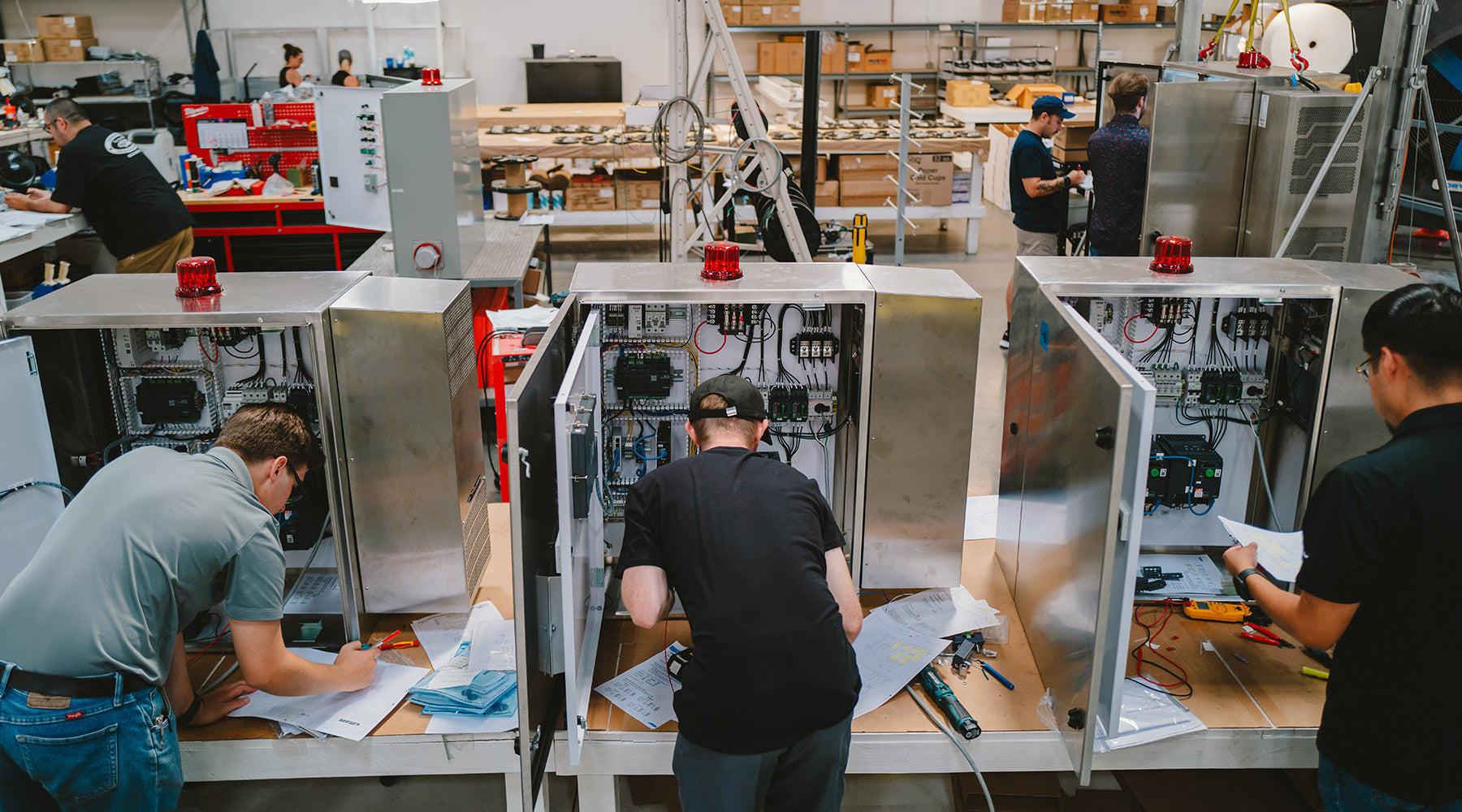By Anthony Castro
Last updated February 7, 2025
What is a Quality Control?
Quality control and quality assurance, often referred to as “QC” and “QA”, are critical steps in the manufacturing process that are used by businesses to guarantee a product has met the quality standards and requirements for a customer/client. Quality control and quality assurance begin with the idea that we must always strive for perfection. Human error will always be a factor in any process, but with training, benchmarking, and checklists in place, you can achieve exponentially greater results.
Quality Control Definition
Quality control is a systematic process designed to ensure that products or services meet specific quality standards. It involves monitoring and inspecting products or services at various stages of production or delivery to identify and correct any deviations from the established quality standards. The primary objective of quality control is to prevent defects or errors from occurring in the first place by implementing measures to control and improve the production or service delivery processes. By adhering to stringent quality control qc practices, businesses can ensure that their products consistently meet the desired quality standards, thereby enhancing customer satisfaction and maintaining a strong reputation in the market.
Quality Control Process
The quality control process typically involves several stages, each crucial for maintaining high quality standards:
-
Planning: This initial stage involves defining quality objectives and identifying the processes that need improvement. Clear planning sets the foundation for effective quality control.
-
Implementation: During this stage, quality control measures such as inspections and testing are put into place to ensure that products or services meet the established quality standards.
-
Monitoring: Continuous monitoring of the quality control process helps in identifying areas that require improvement. This stage is vital for maintaining consistent quality.
-
Corrective Action: When quality issues are identified, taking corrective action is essential. This involves addressing the root causes of the problems to prevent recurrence.
-
Continuous Improvement: The final stage focuses on continuously improving the quality control process to ensure it remains effective and efficient. This ongoing effort helps in adapting to new challenges and maintaining high quality standards.
By following these stages, businesses can establish a robust quality control process that ensures their products or services consistently meet quality standards, thereby enhancing customer satisfaction and business reputation.
Why is Quality Control Important?
Quality control is important because it can:
-
Encourage quality along every step: Quality control pushes employees to ensure the quality of the products throughout the entire manufacturing process. This helps reduce any errors and allow the quality goal to be reached every time. In addition to quality control, a quality assurance program is essential for maintaining high standards through audits, continuous improvement, and effective systems.
-
Reduce “waste”: Quality control allows for businesses to ensure that the correct steps are in place to correct any problems along the manufacturing process. The quality control process allows for different checks and rejects inadequate products earlier in the production process for corrections, which saves time and money. Inadequate products can lead to wasted production time, be dangerous to employees, harm customers, ruin the business’s reputation and/or lead to lawsuits.
-
Improve production methods: Quality control allows for a proactive approach to analyze and continually improve production processes and methodologies. If a process is not working properly, the quality control process will change and evolve to meet the quality requirements to ensure the most efficient process is in place.
-
Raise employee morale: When employees recognize that they’re producing high-quality products that deliver value to consumers, it can improve overall company morale.
-
Increase customer satisfaction: By providing quality products, customers will receive non-defective products and increase customer satisfaction.
-
Enhance business reputation and sales: Being able to consistently produce quality products and increase customer satisfaction raises the business’s reputation throughout the industry. Once one customer is satisfied, new customers are more likely to reach out and increase sales.
Types of Quality Control
There are several types of quality control methods that businesses can implement to ensure their products meet the desired quality standards. Each method has its own strengths and is suited to different aspects of the manufacturing or business process.
Control Charts
Control charts are a statistical tool used to monitor and control processes over time. They help track the performance of a process and identify any deviations from the expected performance. Commonly used in manufacturing processes, control charts are essential for maintaining the quality of products and identifying defects or errors early.
Control charts typically consist of three main components:
-
The Center Line: Represents the expected performance of the process.
-
The Upper Control Limit: Indicates the maximum acceptable deviation from the expected performance.
-
The Lower Control Limit: Indicates the minimum acceptable deviation from the expected performance.
By using control charts, manufacturers can quickly identify any deviations from the expected performance and take corrective action to address any quality issues. This helps ensure that products meet quality standards and reduces the risk of defects or errors.
In addition to control charts, there are several other types of quality control methods, including:
-
Acceptance Sampling: This method involves selecting a random sample of products from a batch and inspecting them to determine whether the batch meets quality standards. It is a cost-effective way to ensure quality without inspecting every single product.
-
Statistical Process Control (SPC): This method uses statistical methods to monitor and control processes. SPC helps in identifying variations in the process that could lead to defects, allowing for timely corrective actions.
-
Total Quality Management (TQM): TQM is a comprehensive approach to quality management that involves all employees and departments in the organization. It focuses on continuous improvement and customer satisfaction.
-
Lean Manufacturing: This method involves a systematic approach to eliminating waste and improving efficiency in manufacturing processes. Lean manufacturing aims to deliver high-quality products while reducing costs and increasing productivity.
Each of these quality control methods has its own strengths and weaknesses. The choice of which method to use will depend on the specific needs and goals of the organization. By implementing the appropriate quality control methods, businesses can ensure that their products meet the highest quality standards, leading to increased customer satisfaction and a stronger market reputation.
How to Implement Quality Control
1. Setting the Quality Standards
To begin any quality control process, there must be established standards that the business would like to meet as part of a comprehensive quality assurance system. The root of many issues are caused by unclear standards and incorrect assumptions, so in order to avoid that, all department leaders must review and sign off on what the standards should be.
2. Testing the Quality Control Process
Before launching any new production and quality control procedure, test environments can be set up to test out new procedures before launching them into the production process. In the context of software development, software quality assurance (SQA) involves systematic testing and process optimization to ensure the quality of software products. When doing these additional tests it is critical to set up the test environment to be as close as possible to the production environment. If the new procedure deems to be effective, it can be added into the production environment.
3. Observations During the Manufacturing Process
Once the process is outlined, it is critical to constantly observe every step through the manufacturing process to maintain an effective quality control process. Quality control specialists play a crucial role in observing and maintaining the effectiveness of the quality control process throughout the manufacturing stages. This will enable you to determine if the process is working correctly or if it is breaking down. New issues can arise outside of a test environment so if it breaks down along the way, the issue must be identified, documented, and corrected.
4. Correct Problems
Issues must be always identified, documented, and followed with corrective action to prevent them from happening again in the future. Effective quality management practices involve systematic processes and feedback mechanisms to identify and correct issues promptly. The corrective action that takes place is dependent on the issue at hand, but it is important to collaborate with any required personnel to analyze and brainstorm to come up with the best solution. Flowcharts can also serve as a visual tool to help identify what were the root causes of the problem.
5. Collecting Data
Once the procedure is flowing smoothly, data should be collected for management to review and rate its effectiveness or make decisions. Collecting data is an integral part of various quality assurance methods that help in monitoring and improving the production process. For example, the company may decide to repair any remaining defective units or eliminate them. Similarly, if too many of the products are defective, it’s best for the company to establish a plan for improving the production process or, if the problem is with the supplies being used, purchasing raw materials from elsewhere. It’s important for the company to continue using its quality control method to monitor for new signs of problems.
Summary
Quality control is not a one size fits all and every business should tailor its processes based on its industry and products. To understand the broader context, it is essential to know what is quality assurance, which is a systematic process aimed at ensuring that products and services meet specific standards and requirements. Any business looking to scale and gain a competitive advantage should implement its own quality control process. A successful quality control process will ensure that standards of quality are met, rectify problems, boost company morale and reputation and raise the bar for the quality of products.
References
-
"What is Quality Control? Definition, Importance and Methods," Indeed Editorial Team, Indeed, January 22, 2024
-
"5 Steps to Build and Improve Your QA Process," Shiridi Gandham, Tiny Technologies, Inc., September 17, 2024
-
"The Quality Control Process: 6 Steps to Better Parts," Winndeavor, November 23, 2022
-
"Quality Control in Manufacturing: Best Practices to Prevent Errors and Ensure Consistent Output," Iwona Adamska, National Centre for Research and Development, April 7, 2023
-
"Cost Reduction Through Quality Assurance (QA)," Consulting Check, Accessed October 2, 2024





Share:
What is a Pump Control Panel?
Top 8 Signs Your Pump Control Needs Maintenance